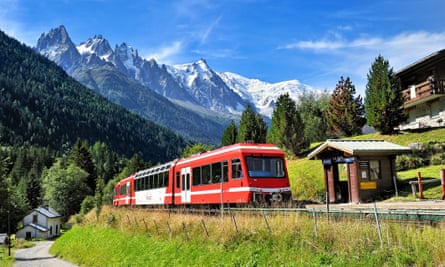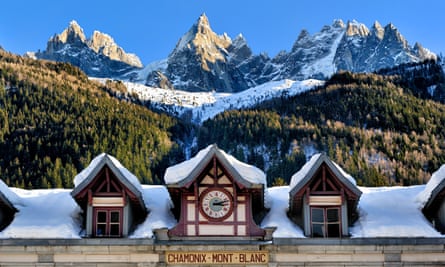
Martigny enjoys a beautiful setting where the waters of the River Dranse tumble down to join the Rhône in Switzerland’s Valais canton. The town is a natural way station for travellers following the classic Grand St Bernard route south into Italy. The chic set stop off in Martigny en route to Verbier.
Switzerland has so many celebrated metre-gauge mountain railways, among them an outstanding trinity of lines that are boldly promoted to overseas tour operators and have ample capacity to handle large groups. Those three crowd-pullers are the wonderful Bernina railway from the Upper Engadine to Tirano in Italy, the steeply graded line from Brig to Andermatt and beyond (used by the Glacier Express) and the fine GoldenPass route running west from the Thunersee via the Simme Valley to Gstaad and Montreux.
By contrast, the hourly Mont-Blanc Express railway from Martigny to Saint-Gervais-les-Bains in France is relatively unsung, yet in my opinion rates as rewarding as the Bernina, Glacier and GoldenPass routes. The Mont-Blanc Express tussles with topography, cutting through fierce rocky terrain above the Trient Gorge and then following the ominously named Eau Noire upstream across the border into France. The railway then dives into a long tunnel, before dropping down into the Chamonix Valley and following the River Arve down to Saint-Gervais-les-Bains, where there are connections to the Geneva area.
Although promoted as the Mont-Blanc Express, the 24-mile (38km) journey from Martigny to Saint-Gervais is no fast dash, taking well over two hours and averaging only 15 mph. There are over two dozen intermediate stations, though many are request stops. When I made this journey in May 2023, I took a full day for it, stopping off along the way.
Bold engineering
The notion of a narrow-gauge mountain railway from the Valais region over the hills to Chamonix in France gained traction in the 1880s as investors saw how Niklaus Riggenbach’s rack system, pioneered on the Rigi Railway in 1871, was allowing cog railways to access remote mountain communities. The line from Martigny through to Saint-Gervais via Chamonix wasn’t completed until 1908 and initially it was suspended during the winter months. Better avalanche protection later allowed year-round operation. When it came to electrifying this route, there were debates whether third rail or overhead wires were the best option; neither side won, and the line uses a mix of both methods.

Platform 40 at Martigny station is easily missed, tucked away beyond the main platforms. The red and white Mont-Blanc Express slips out of Platform 40 on time and with no great fanfare. There’s a tantalising glimpse to the left of the fierce ravine cut by the River Trient as it cascades down from the heavily glaciated mountains away to the south. Then we start to climb steeply and I appreciate why engineers opted for a cog railway for this section of the line. The train passes by great cliffs, twisting and turning with a feast of neck-craning panoramic views.
I make a first stop at Salvan, a small village with a neat station styled in the manner of an Alpine chalet. The road which leads past the station is called Rue Marconi, a reminder it was here that Italian inventor Guglielmo Marconi conducted early experiments in wireless telegraphy. Joining the next train an hour later, we quickly crest the thousand-metre contour with welcome hints of spring sunshine.
There’s an announcement: “Prochain arrêt: Le Trétien”. The Mont-Blanc Express duly rolls to a halt at Le Trétien. This is too good a chance to miss, so on a whim I alight. This is a gorgeous village high above the Trient Valley, and a jumping-off point for hikers wanting to explore the Trient Gorge. The area was bypassed in the heyday of tourism development in this region, when resorts like Zermatt, Crans-Montana and Chamonix shot to prominence. But by the 1880s, adventurous travellers were making their way to Salvan and Le Trétien, drawn by a magical mix of glaciers, rugged scenery and pastoral beauty. In a pleasant hour wandering steep alleys and lanes around Le Trétien, I meet only one other person and our paths cross twice, each time with a reciprocal smile and a nod.
All too soon, I am back at Le Trétien’s lonely station platform, indicating with a wave of my hand that I’d like the approaching train to stop. For the third time today, I am bound for France and within 20 minutes we are slipping over the border.
after newsletter promotion
The Chamonix valley
It is well known that the ambition of train operators flags at frontiers and an announcement indicates everyone must change on to a French train at Vallorcine. This is standard practice on the Mont-Blanc Express, which is actually two well-coordinated train services run respectively by Swiss and French operators. It’s an easy cross-platform change of train, and within a few minutes we are on our way again, now on a French train but also prominently branded as the Mont-Blanc Express.

We are still climbing, through a long tunnel under the Col des Montets. When the road over the pass is closed by snow, the rail tunnel provides the only link between Vallorcine and the Chamonix Valley. So there’s a creative sharing of the narrow tunnel, allowing cars to drive through when no train is scheduled. It’s an arrangement that has not yet led to disaster.
Emerging from the tunnel into the sunlit valley of the River Arve, there are glorious views on the run down to Chamonix, with the rubbly moraines on the Glacier d’Argentière high to the left. I make a third and final stop at Chamonix, enjoying a wander through this pleasant town where the entire economy is defined by mountain tourism. The town’s official name is Chamonix-Mont-Blanc, but the clouds do not cooperate so I am denied a good view of the highest peak in the Alps.
By late afternoon, I am back on the train, now with frequent stops and more like a tram, as we slowly drop down to Saint-Gervais-les-Bain. Elevated concrete highways loop assertively over the railway as a reminder that we are returning to more populated terrain. I didn’t see Mont Blanc on this occasion, but I still found this international route a remarkable railway adventure.
Tickets from Martigny to Chamonix (€34.40) or Saint- Gervais-les-Bains (€44.40) can be bought from Rail Europe. Or exploit the real flexibility of Interrail and build this one-day trip into a longer journey through the Alps.
Nicky Gardner is the editor of Hidden Europe magazine and the co-author of Europe By Rail: The Definitive Guide, available from guardianbookshop.com



